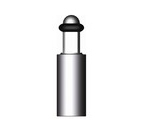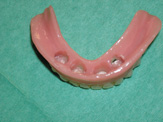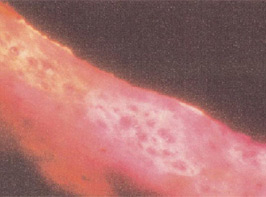Mini Dental Implants
-
Mini Dental Implants
 Due to their small diameter of 1.8mm – 2.4mm, MDI Implantology Mini Dental Implants are well suited for atrophied bone, often without the need for bone grafting.¹ Just one session might be enough to achieve long-term stabilisation of the denture¹ and positively impact your patient’s quality of life²
Due to their small diameter of 1.8mm – 2.4mm, MDI Implantology Mini Dental Implants are well suited for atrophied bone, often without the need for bone grafting.¹ Just one session might be enough to achieve long-term stabilisation of the denture¹ and positively impact your patient’s quality of life²References
¹Ahn M-R, An K-A, Choi J-H, Sohn D-S. Immediate loading with mini dental implants in the fully edentulous mandible. Implant Dent 2004; 13: 367-372. ²Griffitts, T. M., Collins, C. P., Collins, P. C. Mini dental implants: An adjunct for retention, stability, and comfort for the edentulous patient. Oral Surgery, Oral Medicine, Oral Pathology, Oral Radiology and Endodontology, 100 (5): E81-E84, 2005Product Reviews
Product information
Features and benefits
- Minimally invasive protocol¹
- Often no grafting necessary¹
- Immediate load possible in the mandible (stabilisation of dentures)¹
- Very cost-effective for the dental practice²
- Available diameters: 1.8 – 2.1 – 2.4 mm
- Available lengths: 10 – 13 – 15 – 18 mm
- Available abutmens: O-Ball Head – Square Head
- Variants: collared (thick gingiva) – classic (thin gingiva)
¹Ahn M-R, An K-A, Choi J-H, Sohn D-S.(2004) Immediate loading with mini dental implants in the fully edentulous mandible. Implant Dent
13: 367-372.
²Griffitts, T. M., Collins, C. P., Collins, P. C. Mini dental implants:(2005). An adjunct for retention, stability, and comfort for the edentulous patient. Oral Surgery, Oral Medicine, Oral Pathology, Oral Radiology and Endodontology, 100 (5): E81-E84
Indications
Functional principles
Implants are placed through a small pilot hole which is prepared with a 1.1 mm drill. No full osteotomy! Usually, the average depth is one-third to one-half the threaded length of the implant.
- A transgingival procedure is possible in many cases.¹
- The self-tapping design offers maximum primary stability (principle of osseo-compression). Especially in the mandible, immediate loading is therefore often possible (denture stabilisation).¹
- Prosthetic concept for denture stabilisation = soft loading: O-Rings in the attachments offer retention and simultaneously absorb the load. Original retention can be restored by simply changing an O-Ring. The dentures are still tissue-borne and thus, the load is not carried by the implants to the full extent.²
- Attachment designs with O-Rings forgive up to 30° divergence between two implants.¹
¹Ahn M-R, An K-A, Choi J-H, Sohn D-S.(2004) Immediate loading with mini dental implants in the fully edentulous mandible. Implant Dent 13: 367-372. ²Griffitts, T. M., Collins, C. P., Collins, P. C. Mini dental implants:(2005). An adjunct for retention, stability, and comfort for the edentulous patient. Oral Surgery, Oral Medicine, Oral Pathology, Oral Radiology and Endodontology, 100 (5): E81-E84
Information for Implants
Classic MDI implants with O-ball without collar S1810OB – S1818OB MDI
1.8 mm implantMaterial: Titanium Grade 5 (titanium alloy Ti 6Al 4V)
One-piece implant without collar
Indication: mandibular denture stabilization, gingivalheight < 2 mm
Sterile packed
Ø= 1,8mm
L= 10/13/15/18 mm (the indicated lengths refer to the respective length of the thread!)
Corresponding lab analog: #5118#S1810OB Ø= 1.8mm L: 10mm
#S1813OB Ø= 1.8mm L: 13mm
#S1815OB Ø= 1.8mm L: 15mm
#S1818OB Ø= 1.8mm L: 18mm

S1810IOB – S1818IOB MDI 2.1 mm implant
Material: Titanium Grade 5 (titanium alloy Ti 6Al 4V)
One-piece implant without collar
Indication: mandibular denture stabilization, gingivalheight < 2 mm
Sterile packed
Ø= 2.1mm
L= 10/13/15/18mm (the indicated lengths refer to the respective length of the thread!)
Corresponing lab analog: #5118#S1810IOB Ø= 2.1mm L: 10mm
#S1813IOB Ø= 2.1mm L: 13mm
#S1815IOB Ø= 2.1mm L: 15mm
#S1818IOB Ø= 2.1mm L: 18mm

S1810MOB – S1818MOB MDI 2.4mm implant
Material: Titanium Grade 5 (titanium alloy Ti 6Al 4V)
One-piece implant without collar
Indication: maxillary denture stabilization, gingivalheight < 2 mm
sterile packed
Ø= 2.4mm
L= 10/13/15/18mm (the indicated lengths refer to the respective length of the thread!)
Corresponding lab analog: #5118#S1810MOB Ø= 2.4mm L: 10mm
#S1813MOB Ø= 2.4mm L: 13mm
#S1815MOB Ø= 2.4mm L: 15mm
#S1818MOB Ø= 2.4mm L: 18mm
MDI Implants with O-ball and collar OB-10 – OB-18 MDI 1.8 mm implant
Material: Titanium Grade 5 (titanium alloy Ti 6Al 4V)
One-piece implant with polished collar
Indication: mandibular denture stabilization, gingivalheight > 2 mm
Sterile packed
Ø= 1.8mm
L= 10/13/15/18 mm (the indicated lengths refer to the respective length of the thread!)
Corresponding lab analog: #LAOB# OB-10 Ø= 1.8mm L: 10mm
# OB-13 Ø= 1.8mm L: 13mm
# OB-15 Ø= 1.8mm L: 15mm
# OB-18 Ø= 1.8mm L: 18mm

IOB-10 – IOB-18 MDI 2.1 mm Implantat
Material: Titanium Grade 5 (titanium alloy Ti 6Al 4V)
One-piece implant with polished collarIndication: mandibular denture stabilization, gingival
height > 2 mm
Sterile packed
Ø= 2.1mm
L= 10/13/15/18 mm (the indicated lengths refer to the respective length of the thread!)
Corresponding lab analog: #LAOB# IOB-10 Ø= 2.1mm L: 10mm
# IOB-13 Ø= 2.1mm L: 13mm
# IOB-15 Ø= 2.1mm L: 15mm
# IOB-18 Ø= 2.1mm L: 18mm

MOB-10 – MOB-18 MDI 2.4 mm Implant
Material: Titanium Grade 5 (titanium alloy Ti 6Al 4V)
One-piece implant with polished collar
Indication: maxillary denture stabilization, gingivalheight > 2 mm
Sterile packed
Ø= 2.4mm
L= 10/13/15/18 mm (the indicated lengths refer to the respective length of the thread!)
Corresponding lab analog: #LAOB# MOB-10 Ø= 2.4mm L: 10mm
# MOB-13 Ø= 2.4mm L: 13mm
# MOB-15 Ø= 2.4mm L: 15mm
# MOB-18 Ø= 2.4mm L: 18mm
MDI Implants with square head and collar SH10 – SH18 MDI 1.8 mm Implant
Material: Titanium Grade 5 (titanium alloy Ti 6Al 4V)
One-piece implant with polished collar
Indication: fixed restorations in the mandible
Sterile packed
Ø= 1.8mm
L= 10/13/15/18 mm (the indicated lengths refer to the respective length of the thread!)
Corresponding lab analog: #LASH# SH-10 Ø= 1.8mm L: 10mm
# SH-13 Ø= 1.8mm L: 13mm
# SH-15 Ø= 1.8mm L: 15mm
# SH-18 Ø= 1.8mm L: 18mm

MSH10 – MSH18 MDI 2.4 mm Implant
Material: Titanium Grade 5 (titanium alloy Ti 6Al 4V)
One-piece implant with polished collar
Indication: Fixed restorations in the maxilla
Sterile packed
Ø= 2.4mm
L= 10/13/15/18 mm (the indicated lengths refer to the respective length of the thread!)
Corresponding lab analog: #LASH# MSH-10 Ø= 2.4mm L: 10mm
# MSH-13 Ø= 2.4mm L: 13mm
# MSH-15 Ø= 2.4mm L: 15mm
# MSH-18 Ø= 2.4mm L: 18m

Prosthetics components
Prosthetic components Standard Metal Housing (accommodates O-Ring)
Material: Grade 5 Titanium (titanium alloy Ti 6Al 4V)
Diameter:4.75 mm
Height:3.6 mm (Item No: MH-1)

Micro Metal Housing (accommodates O-Ring)
Material: Grade 5 Titanium (titanium alloy Ti 6Al 4V)
Diameter: 4.3 mm
Height: 3.3 mm(Item No: MH-2)

O-Cap Metal Housing (accommodates O-Ring)
Material: Grade 5 Titanium (titanium alloy Ti 6Al 4V)
Diameter: 4.0 mm
Height: 3.0 mm(Item No: MH-3)

Replacement O-Ring for Metal Housing MH-1 (single)
Material: nitrile
(Item No: 0550-01)

Replacement O-Ring for Metal Housing MH-1 (pack of 10)
Material: nitrile
(Item No: 0550-10)

Replacement O-Ring for Metal Housing MH-1 (pack of 25)
Material: nitrile
(Item No: 0550-25)
Replacement O-Ring for Metal Housing MH-2 and MH-3 (single)
Material: nitrile
(Item No: 0351-01)

Replacement O-Ring for Metal Housing MH-2 and MH-3 (pack of 10)
Material: nitrile
(Item No: 0351-10)
Replacement O-Ring for Metal Housing MH-2 and MH-3 (pack of 25)
Material: nitrile
(Item No: 0351-25)
Lab Analogs and Restorative Copings MDI O-Ball Prosthetic Head Analog (for implants without collar)
(Item No: 5118)

MDI Collared Standard O-Ball Analog (for implants with collar)
(Item No: LAOB)

MDI Collared Standard Square Head Analog (for implants with collar)
(Item No: LASH)

MDI Impression & Waxing Coping
Compatible with O-Ball & Square Head Implants.(Item No: S4118)

O-Ball Impression Coping
Note: not compatible with Square Head Implants!(Item No: 2921)

MDI O-Ball Immediate Temporization Cap
Note: not compatible with Square Head Implants!(Item No: 2924)

Blockout Shims (pack of 25)
(Item No: S1010)

Information for Instruments and accessories
MDI Surgical and Restorative Kit
1303: 1x MDI Surgical Box
8070: 1x Adjustable Torque Wrench
1030: 1x Titanium Locking Pliers
S1011: 5x MDI 1.1 mm Surgical Drill
S9030: 1x MDI Finger Driver
S9032: 1x MDI Winged Thumb Wrench
S7007: 1x MDI-Ratchet Adapter Short
8016: 1x Ratchet Extension 16 mm
S1010: 1x Blockout Shims (pack of 25)
8720: 1x SECURE™ Hard Pick-Up Kit
(Item No: S1806)
MDI Surgical kit
0121: 1x MDI Small Surgical Box
8070: 1x Adjustable Torque Wrench
S7007: 1x Ratchet Adapter
S9030: 1x MDI Finger Driver
S9032: 1x MDI Winged Thumb Wrench
S1011: 3x 1,1 mm Surgical Drill
S1010: 1x Blockout Shims (Pack of 25)
(Item No: S1807)
Site Preparation Ridge Mapping Caliper
Ridge mapping for determination of alveolar ridge width
(Item No: 1325)

1.5 mm Disposable Tissue Punch
Sterile Packed; for single patient use
(Item No: S0150)

Surgical drills MDI 1.1 mm Surgical Drill
Sterile packed (for single patient use)
(Item No: S1011)

MDI 1.3 mm Surgical Drill
Non-sterile packed, reuseable
(Item No: S1013)

Irrigated Drill Extender
Ø= 3.5mm
Sterile packed
Material: Surgical steel(Item No: 2000)

Insertion Instruments MDI Winged Thumb Wrench
(Item No: S9032)

Ratchet Wrench
For final insertion
(Item No: 8010)

Adjustable Torque Wrench
including Adapter 4mm square
Torque: 10 – 70 Ncm
(Item No: 8070)

Replacement O-Ring for Insertion Instruments (Pack of 10)
(Ratchet Extension, Ratchet Adapter or Initial Finger Driver)
Material: nitrile(Item No: 0551-10)

MDI Ratchet Adapter MDI Ratchet Adapter Short
Height: 5 mm
(Item No: S7007)

MDI Ratchet Adapter Medium
Height: 9mm
(Item No: S7011)

MDI Ratchet Adapter Long
Height: 13mm
(Item No: S7015)

Ratchet Wrench Extension
Height: 16mm
(Item No: 8016)

MDI Surgical Box
Instruments are not included
(Item No: 1303)

Small Surgical Box
Instruments are not included
(Item No: 0121)

Patient Demonstration Models MDI Model Mandible Clear Acrylic Base
(Item No: SMDI-001)

MDI Model Mandible Pink Acrylic Base
(Item No: SMDI-004)

Product Reviews
Denture Stabilization in the Mandible, Dr. Winfried Walzer, Berlin, Germany.
An edentulous male patient in his mid 40s came to our dental practice in Berlin since he had problems with his mandibular denture. He reported that he used denture adhesives for fixation. Nevertheless, functionality and stability of this prosthesis were insufficient – it was so loose that he even had difficulty chewing. Since he was not able to carry the financial burden of a conventional implant treatment and desired a quick, comfortable solution, it was decided to place four MDI Mini Dental Implants in the anterior mandible for denture stabilization. Since the old prosthesis was in poor condition, the dentist, dental technician and patient agreed that a new denture should be fabricated in the dental laboratory.

Figure 1: The MDI Mini Dental Implants are available in four different diameters …

Figure 2: ….. and four lengths

Figure 3: Determination of the soft tissue depth using a periodontal probe

Figure 4: Marking of the implant positions in the mouth using a template

Figure 5: Blood indicates the desired implant locations

Figure 6: Drilling a pilot hole to a depth of one third to one half o the selected mini implant

Figure 7: Placement of the first mini dental implant

Figure 8: Implant insertion using a finger driver

Figure 9: Implant insertion using a winged thumb driver

Figure 10: Putting the implant into its final position with a torque wrench at a torque of 35 to 45 Ncm

Figure 11: Inserting the implants in the desired orientation

Figure 12: The four implants in correct positions

Figure 13: Marking of the implant positions on the denture base

Figure 14: Base prepared for polymerization

Figure 15: Placing the blockout shim on one of the implants

Figure16: The trimmed blockout shim in its ideal position

Figure 17: Placing the prosthesis in the patient’s mouth.

Figure 18: The acrylic sets intraorally under occlusion with normal pressure

Figure 19: Metal housings fixed in the openings of the denture base

Figure 20: The mechanical load is not carried by the implants alone
Product Reviews
Shatkin TE, Shatkin S, Oppenheimer BD, Oppenheimer AJ, Compendium 2007
Mini dental implants for long-term fixed and removable prosthetics : A retrospective analysis of 2514 implants, placed in 531 patients over 5.5 years (mean 2.9 years)
- Minimal exclusion criteria: Severely atrophic bone, active intraoral infection
- Cox Proportional Hazard Model applied for risk evaluation
- Overall 145 Implants failed (5.8%, mobility with/without suppuration), only 2 cases failed!
Authors describe a learning curve with placement experience.
Type prosthesis Survival rate Full lower denture 95% Full upper denture 83% Partial lower denture 93% Partial upper denture 92%
Mean survival rate 90% for removable prosthesis
(implant success criteria by Buser et al.)
Mandible: 95%
Maxilla: 84%Bulard RA, Vance JB, Compendium 2005
Multi-clinic evaluation using mini-dental implants for long-term denture stabilization
A total of 1029 implants were evaluated over 4 months to 8 years
Mean survival rate : 91,2 %
-
Including Clinic‘s E failure rate of 31%!
(Clinic E did not follow the protocol but used full osteotomy instead)
Mean survival rate excl. Clinic E: 94 %
- Success criteria by Albrektsson et al.
- „The overall success of the MDI system is affected by careful case selection and strict adherence to the recommended insertion / reconstructive Protocol“

Figure 1: Mean implant mortality rates for participating clinics
Griffitts TM, Collins CP, Collins PC, Oral Surg Oral Med Oral Pathol Oral Radiol Endod 2005
Mini dental implants: An adjunct for retention, stability, and comfort for the edentulous patient
- 116 Implants in 30 patients, lower & upper dentures, 24 patients evaluated (five months post op)
- „Patients were satisfied with their retention, comfort, and chewing ability“
- „In our practice the cost of 4 MDIs is equal to one conventional implant“
Aspect Results Survival rate (1y) 97.4% subjective Rating of: before > afterwards (1 = poor, 10 = excellent) retention 1.7 > 9.6 comfort 2.2 > 9.4 chewing ability 2.3 > 9.3 speaking ability 5.3 > 8.5 Burton E. Balkin, David E. Steflik, MS, Francie Naval, Journal of Oral Implantology 2001; 27, 32-37:
Mini-Dental Implant insertion with the auto-advance technique for ongoing applications
Histological evaluation of bone- implant interface, 2 retrieved human biopsies, 4 and 5 months post-op.

Low magnification photomicrograph shows close bone congruency to the implant surface

Higher magnification reveals osteocytes within their lacunae
Product Reviews
Catalogs
Video





